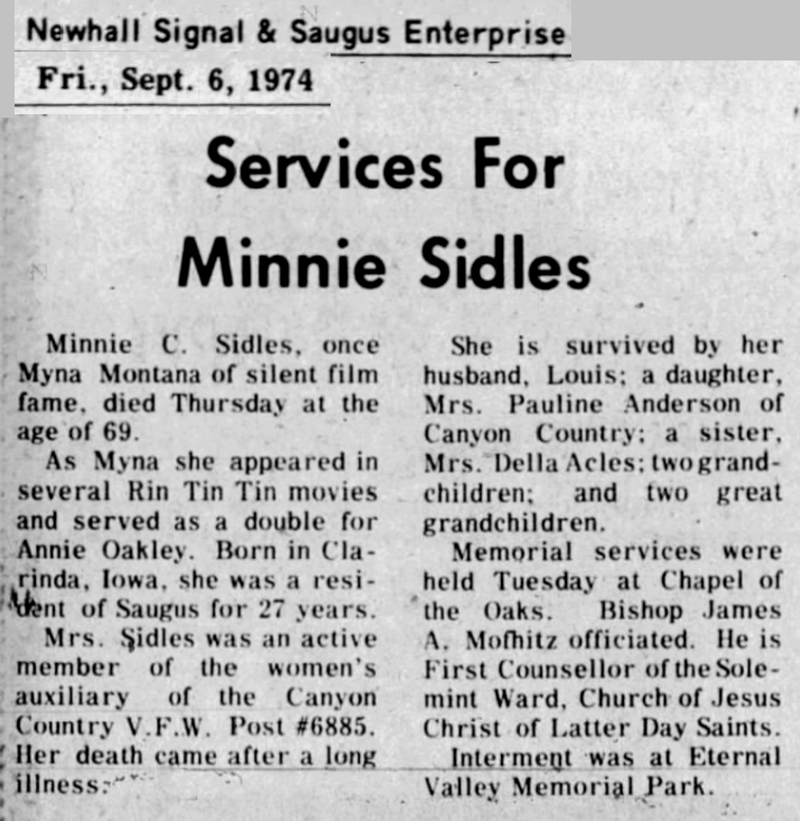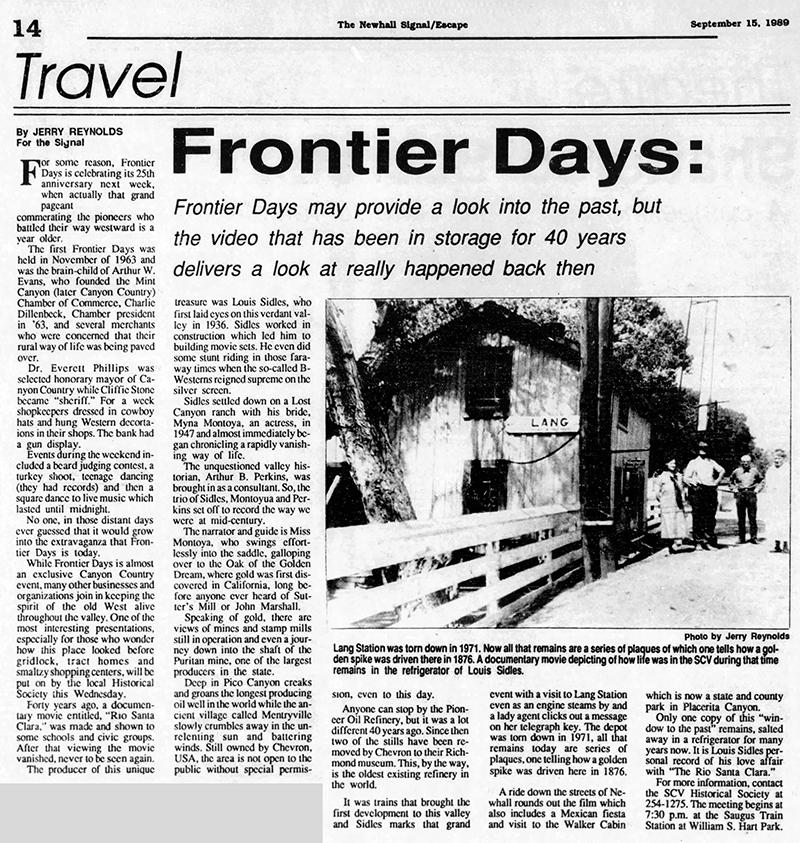
Click to enlarge.
|
It is approximately 1956. The film opens with the co-producer leafing through scrapbooks with clipping of A.B. Perkins' histories that were published in The Signal in the middle of 1954 — and not
his Signal series from 1961-1962. (The physical scrapbooks are in the SCV Historical Society collection.) The narrator notes that Placerita Canyon State Park was dedicated "in 1956."
According to producer
Lou Sidles' grandson Jim Montgomery (pers. comm. 2019), production started in 1955 and was completed in 1956.
We can also date the film from a few things we see in it:
* An annual fiesta-style celebration of Francisco Lopez's 1842 gold discovery in Placerita Canyon, complete with gold panning in Placerita Creek inside the park (verboten today).
* The train depot and other buildings are standing at Ravenna.
* Our tour guide is escorted 300 feet inside the Red Rover mine in Acton.
* Beale's Cut has not yet collapsed.
* Lang Station is in use. (It was razed in 1971.)
* Pico No. 4 is pumping in the canyon back of Mentrville, where the buildings are their original battleship gray color. Rundbergs are resident.
* The Pioneer Oil Refinery off of Pine Street has all four of its stills. Two of the stills were removed sometime between 1955 and 1961. (And now we know it was between 1956 and 1961.)
* There is a working stamp mill (gold ore crusher) which, according to Jim Montgomery, is in Sand Canyon.
Shortly after it was produced, the film was shown at civic functions and then nevermore until 1989 when the Santa Clarita Valley Historical Society showed it at Heritage Junction. (Montgomery donated a copy.) It was transfered to VHS tape in 1990 and put on a shelf until 2019 when it was rediscovered and added to SCVHistory.com — where you are watching it.
NOTE: Just don't take all of the historical details in this film as gospel. We've corrected the record a few times since it was made and continue to do so.

Click image to enlarge.
Frontier Days may provide a look into the past, but the video that has been in storage for 40 years delivers a look at what really happened back then.
The Newhall Signal, Escape Section | September 15, 1989.
For some reason, Frontier Days is celebrating its 25th anniversary next week, when actually that grand pageant commemorating the pioneers who battled their way westward is a year older.
The first Frontier Days was held in November of 1963 and was the brain-child of Arthur W. Evans, who founded the Mint Canyon (later Canyon Country) Chamber of Commerce, Charlie Dillenbeck, Chamber president in '63, and several merchants who were concerned that their rural way of life was being paved over.
Dr. Everett Phillips was selected honorary mayor of Canyon Country while Cliffie Stone became "sheriff." For a week, shopkeepers dressed in cowboy hats and hung Western decorations in their shops. The bank had a gun display.
Events during the weekend included a beard judging contest, a turkey shoot, teenage dancing (they had records) and then a square dance to live music which lasted until midnight.
No one in those distant days ever guessed that it would grow into the extravaganza that Frontier Days is today.
While Frontier Days is almost an exclusive Canyon Country event, many other businesses and organizations join in keeping the spirit of the old West alive throughout the valley. One of the most interesting presentations, especially for those who wonder how this place looked before gridlock, tract homes and shmaltzy shopping centers, will be put on by the local Historical Society this Wednesday.
Forty years ago, a documentary movie entitled, "Rio Santa Clara," was made and shown to some schools and civic groups. After that viewing the movie vanished, never to be seen again.
The producer of this unique treasure was Louis Sidles, who first laid eycs on this verdant valley in 1936. Sidles worked in construction which led him to building movie sets. He even did some stunt riding in those faraway times when the so-called B-Westerns reigned supreme on the silver screen.
Sidles settled down on a Lost Canyon ranch with his bride, Myna Montoya [sic: Montanya], an actress, in 1947 and almost immediately began chronicling a rapidly vanishing way of life.
The unquestioned valley historian, Arthur B. Perkins, was brought in as a consultant. So, the trio of Sidles, Montanya and Perkins set out to record the way we were at mid-century.
The narrator and guide is Miss Montoya, who swings effortlessly into the saddle, galloping over to the Oak of the Golden Dream, where gold was first discovered in California, long before anyone ever heard of Sutter's Mill or John Marshall.
Speaking of gold, there are views of mines and stamp mills still in operation and even a journey down into the shaft of the Puritan [sic: Red Rover] mine, one of the largest producers in the state.
Deep in Pico Canyon creaks and groans the longest producing oil well in the world while the ancient village called Mentryville slowly crumbles away in the unrelenting sun and battering winds. Still owned by Chevron USA, the area is not open to the public without special permission, even to this day.
Anyone can stop by the Pioneer Oil Refinery, but it was a lot different 40 years ago. Since then, two of the stills have been removed by Chevron to their Richmond museum. This, by the way, is the oldest existing refinery in the world.
It was trains that brought the first development to this valley, and Sidles marks that grand event with a visit to Lang Station even as an engine steams by and a lady agent clicks out a message on her telegraph key. The depot was torn down in 1971. All that remains today are series of plaques, one telling how a golden spike was driven here in 1876.
A ride down the streets of Newhall rounds out the film which also includes a Mexican fiesta and visit to the Walker Cabin which is now a state and county park in Placenta Canyon.
Only one copy of this "window to the past" remains, salted away in a refrigerator for many years now. It is Louis Sidles personal record of his love affair with "The Rio Sana Clara."
For more information, contact the SCV Historical Society at 254-1275. The meeting begins at 7:30 p.m. at the Saugus Train Station at William S. Hart Park.



